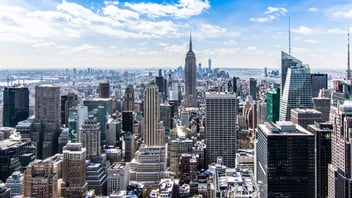4 Practical Ways to Comply with Local Law 97

New York’s new legislation, Local Law 97 (LL97), doesn’t have to be the big, bad wolf if you’re properly prepared. In our recent blog, we covered the guidelines and some FAQs about this law. If your building is covered under LL97, you are required to meet new carbon emissions limits by 2024. That means that you need to start taking immediate action. If not, your business will face fines of up to $268 per ton of CO2; and that’s a hefty price to pay when it can be avoided. Below you’ll find four ways you can use renewable energy solutions to ensure that your business complies with LL97.
Community Solar
Community solar may not be first on your list of solar solutions, but it deserves your attention. Community solar might be the quickest way for many New York building owners to tackle the city’s sustainability goals by 2050 and there’s no cost to sign up. Even if your roof is too small to host solar panels, you can still have access to clean energy solutions through a community solar farm subscription. Community solar not only gets you immediate savings on your utility bill, but it’s more sustainable than fossil fuels. Joining forces with other local businesses and building small community solar projects on commercial rooftops can save you money and help reduce your company’s carbon footprint, too. The subscription itself is free and can be bundled with other Catalyst Power products to bring your costs down and boost your energy efficiency.
Cogeneration
If you’re looking for a way to increase your overall efficiency and reduce high energy costs on-site, cogeneration may be what you need. Cogeneration simultaneously produces heat and electricity to significantly reduce “waste heat,” or high amounts of energy typically lost in the power generation process. The purpose of cogeneration is to recover and reuse that energy in a cost-effective way while supplying heating and cooling to large buildings.
Demand Response
New York offers several demand response program options that reduce your electricity use and lower your monthly electricity bill. As a building owner, you’re paid to cut back on how much power you use through a curtailment event to reduce strain on the grid and reduce carbon emissions. We wrote about ways you can identify if your business needs demand response and which buildings should start curtailing their energy usage now. If you own a large building, chances are you have high energy consumption. Reduce your usage during peak hours of the day and see how much of a difference it makes in your monthly savings! You can also maximize the potential of demand response through battery energy storage. To find out if you qualify for Catalyst Power’s demand response program, check out this post.
Connected Microgrid ®
As a building owner, a Connected Microgrid solution is the best way to reduce carbon emissions. It’s a behind-the-meter solution that offers on-site generation for all your energy needs. The best part? You are not responsible for the cost of maintenance and installation. Catalyst Power will install custom-sized, non-penetrating solar panels and optional battery storage on your property. This allows you to produce and consume renewable energy directly. While your building uses clean energy, this reduces your dependency on the power grid, shaves off-peak pricing, and gives you the environmental benefits you’re looking for.
LL97 compliance might appear to be a thorn in your side now, but there are efficient and sustainable options available to you that offer long-term environmental and financial benefits. Talk to one of our Energy Experts today to find out which solution is best for you and start cutting back on those costly greenhouse gas emissions now.


.jpg?width=352&name=solar%20on%20farm%20(1920%20x%201080%20px).jpg)
